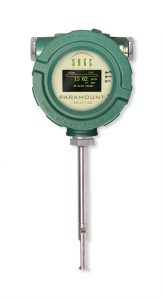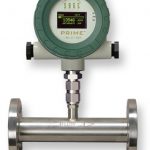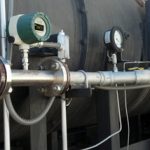Flare Gas Measurement Using Thermal Mass Flow Meters
When looking for a meter for flare gas measurement, many companies are finding significant savings using the thermal mass flow meter versus the ultrasonic flow meter.
Measuring Flare Gas with an Ultrasonic Meter
Waste gas is released into the atmosphere in many operations. Flare stacks are found at oil and gas wells, refineries, well-drilling rigs, natural gas plants, wastewater treatment plants, chemical plants, and landfills. Strict regulations such as the Mandatory Reporting of Greenhouse Gases Rule require operations to measure and record flare gas consumption, often at various points within the process.
Measuring flare gas for most meters is challenging. Ultrasonic flow meters are an effective tool for measuring flare gas. They tolerate some condensed liquid, are not affected by gas composition, and endure fluctuations in pressure and temperature. However, with this type of performance comes high installation costs, ranging from $50,000 to $100,000+ per installation.
Because of this expense, some are finding ways to measure flare gas using thermal mass flowmeters under certain situations.
Thermal Mass Flow Meter Principle of Operation
A thermal mass flow meter measures gas flow based on the principle of heat transfer. Heat is introduced into the gas flow stream, and the rate of how the heat dissipates is measured. The meter’s flow body contains two sensors in contact with the gas. One sensor is heated and serves as a self-heated flow sensor, while the other is a reference sensor that measures the gas temperature. As gas flows by the heated sensor, the flowing gas molecules carry heat away from the sensor, so the flow sensor cools, and energy is lost. The temperature difference between the flow sensor and the reference sensor has changed, and within a second, the circuit heats the flow sensor to replace the energy that has been lost. The mass flow is calculated based on the electricity required to restore and maintain a constant overheat temperature.
New Flare Gas Meter
When flaring known gas composition applications exist, and water vapor isn’t condensing, thermal flow meters make an attractive alternative for flare gas metering. The meter has wide turndown, or up to 1000:1 rangeability, accommodating extreme flow conditions or large flow swings. Low velocities are associated with flare gas under normal venting situations, yet high velocities are typical in upset conditions. Their fast response to flow changes, low-pressure loss, +/- 1%-+/-3% accuracy, and reproducibility make this meter a contender in flare and vent applications.
The Sage Metering flare gas flow meter offers users a unique in-situ calibration check, eliminating the expense and inconvenience of returning the meter to the manufacturer for the recommended annual calibrations.
Slight Inconvenience but Major Savings
Many companies are taking advantage of the cost savings associated with thermal mass flow meters, which are $5000 or less, versus the $50K to 100K+ for an ultrasonic application. Operations realize that by identifying the gas using a gas chromatograph at the flare application, Sage Metering, a thermal mass machine manufacturer, can program their meters to measure the known flare gas. This works for applications where compositional changes are known or are seasonal. While more inconvenient than an ultrasonic meter, the savings often warrant minor aggravation.
It is clear that while thermal mass flow meters are not the perfect choice to measure flare gas, the meter makes good sense in some applications, specifically where the composition is known and where there is no condensation. Also, in applications with known variations, the meter can estimate relaxed accuracy for the uncertainty. Historically, thermal mass flow meters require annual calibration; however, the Sage Metering flare gas meter has onsite, in-situ calibration verification, saving time and the expense of returning the meter for factory calibration and complies with GHG reporting regulations.



